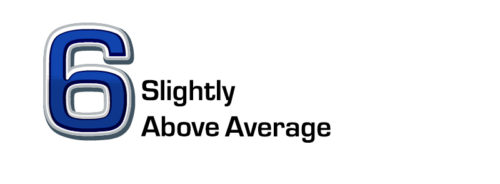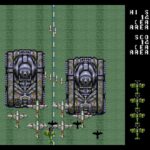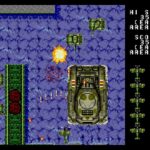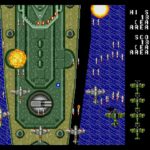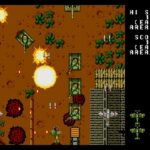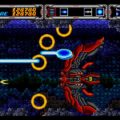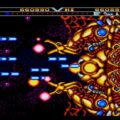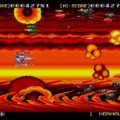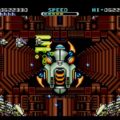Developer: Toaplan Publisher: Sega Release: 06/23/90 Genre: Shooter
Toaplan were one of the most prolific and revered shooter developers of all time. Their catalog is long, storied, and influential. One need only look at the large number of developers that arose when they filed bankruptcy, many of whom are still around today. That being said there was a period where their games began to blend together and they lost me. Between Twin Cobra and Flying Shark and Fire Shark I went looking elsewhere for my shooter fix. Twin Hawk is one of the more interesting of the bunch. But interesting does not mean good.
Twin Hawk resembles Tiger Heli and Flying Shark so much it is easy to mistake it for a sequel to those titles. Taking place in an alternate World War II Twin Hawk sees the fictional countries of Gorongo and Fuangania at war. Gorongo has no air support, revealing a weakness that their enemies are keen to exploit. You pilot a fighter plane named the Big Whirlwind to take out the enemy leader.
By shooter standards the weapon system in Twin Hawk is minimal. There is only one power-up to increase the power of your primary cannon. At max power your shots will consist of a wide stream of eight parallel missiles. It sounds impressive but the power is lacking. There are no bombs; instead you can call in a squadron of back-up fighters to assist you. The support squadron of six ships arrives in formation and allows you to blanket the entire screen in fire. They die in one hit but it is incredibly fun to keep them alive as long as possible to make the levels trivial. Once shot they perform a kamikaze dive for a possible hit. You can also initiate this yourself to make them one massive suicide bomb. But extra supports are rare so this use has to be measured.
Although you pilot a fighter jet your opposition consists entirely of ground forces. This makes the game unique within the genre but I cannot say it is for the better. This limits the game’s scope as you face a seemingly never ending parade of trucks, tanks, and battleships. It would be one thing if they varied their designs. But the game is content to feature the most generic assortment of vehicles and grows old fast. Occasionally a larger tank or gunship will attack and is the closest the game comes to a boss battle. When combined with the overly brown and mediocre graphics and especially bad music and Twin Hawk has an uphill battle to grab your attention. Limiting the game in these ways is certainly a choice. But it was not the right one.
Despite the game’s slow pace it manages a level of intensity that is unexpected. Enemy waves are frequent and always in large numbers. It is not uncommon to see them attack from all sides with larger mobile vehicles backed up by smaller tanks. This is where skillful use of your squadrons comes into play. Your ship does not move fast enough to destroy every enemy on screen. But once in formation the squadron covers nearly the entire playing field. Dodging bullets is harder to keep them alive but worth it to rack up points. This is the only exciting aspect of the gameplay as it is otherwise stale and boring.
Even by shooter standards Twin Hawk is short. There are only four levels and each is gruelingly long. There are no level breaks; the game plays as one long continuous mission with the only indication of a new area being the UI updating. The game loops twice and counts the second loop as new stages but they are the same just harder. After that it loops indefinitely but between the lacking enemy variety and its high difficulty it grows old fast. Trying to game the system to attain high scores with your squadron adds some nuance to the gameplay but not enough to warrant playing this game over the far better options available on the Genesis.
In Closing
Twin Hawk is decent for what it is. But there are far better shooters from the same developer on the platform. Overall the game is too repetitive for its own good to make score chasing remotely interesting. I did not hate Twin Hawk but see no reason to ever revisit either. Take that as you will.
